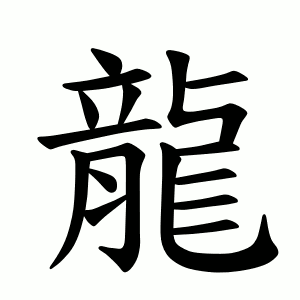龍
- dragon, mireu;
- emperor;
Etymology
This character is a pictograph that depicts the shape of a snake with a 辛-shaped ornament on its head. Because a dragon is an imaginary creature, it was difficult to depict directly, so the ancient scribes modeled it after a snake with a distinctive decoration on its head.
In the Chinese zodiac (十二支), the dragon is represented not by 龍 but by the character 辰 (Chen), which originally referred to a celestial body.
Usage in Korean
Beyond simply meaning “dragon,” the character 龍 also carries the connotation of “emperor” or imperial authority. For example:
袞龍袍 (곤룡포) – imperial dragon robe
龍顔 (용안) – “dragon face,” a term for the emperor’s visage
Although the character has many strokes, you can break it down (dissect it) as 立月卜己三, which may help with memorizing how to write it.
In Japanese Shinjitai (simplified characters), the simplified form 竜 is used. This character is actually an older form (古字) of 龍. Both 龍 (kyūjitai) and 竜 (shinjitai) are commonly used in Japanese names and everyday language. A similar example is:
澤 (택) → 沢 (simplified form)
As a Radical:
Due to its complexity, 龍 is rarely used as a radical. Besides 龍 itself, some characters like:
龐 (방, "confused"), occasionally seen in names like Pang Tong (방통),
龕 (감, “niche or shrine”)
龔 (공, “respectful”)
龑 (엄, “brilliant” or “high”)
are examples of characters using 龍 as a component.
Interestingly, although 龍 is often not the phonetic part, many characters that include it are still categorized under the 龍 radical.
When used phonetically, 龍 often results in the readings “ryong,” “ryu,” “long,” or “rong.” Examples of such characters (often appearing in Chinese character proficiency tests) include:
籠 (롱, "basket")
壟 (롱, "raised field edge")
瓏 (롱, "jade tinkling sound")
聾 (롱, "deaf")
朧 (롱, "dim, hazy")
瀧 (롱, "waterfall")
隴 (롱, "mountain pass")
There are also some characters where 龍 is the phonetic base, but the pronunciation changed slightly over time:
龐 (방, "confused")
寵 (총, "favor, affection")
The character 襲 (습, “to attack” or “invade suddenly”) was originally written with two 龍 characters (龖) but was later simplified.
Finally, the character with the highest stroke count that uses 龍 is 𪚥, composed of four 龍 characters, and means “talkative”. It has 64 strokes in total.
Words that derived from 龍
- 卜月卜尸心 (YBYSP)
- ⿰ 𦚏 ⿱⿺ 𠃑 一 ⿺ 乚 亖
